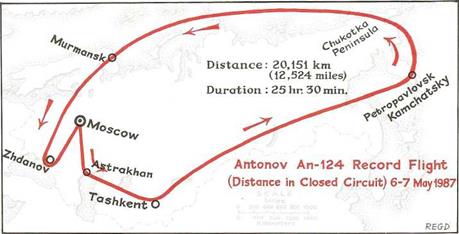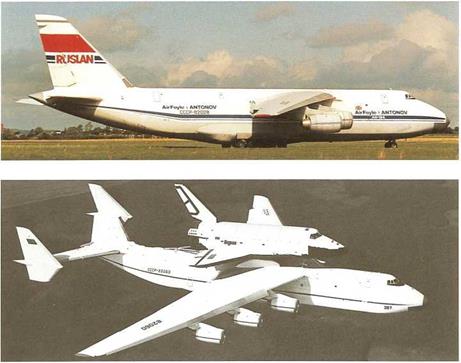World’s Biggest
The Mostest
Sheer size has always fascinated people in all walks of life. The tallest building, the longest bridge, the biggest ship, the highest mountain, the longest river; all these have excited a natural curiosity, and though the world’s natural wonders are unchanging, mankind has constantly tried to build things bigger, even if they are not better. The Russians have shared this urge and attempted, none too successfully, to build outsize aircraft during the 1930s. After the Second World War, the banner for bigness was taken up by the Ukraine, whose Antonov Design Bureau produced a fine series of large freighter aircraft.
The pictures and the diagrams on this and the following page tell their own story. Except for its six-engined cousin (see below), the Antonov An-124 Ruslan, tipping the scales at more than 400 tons, is, by a comfortable margin — 55 tons — the world’s largest aircraft to be produced in quantity.
Standard payload for the An-124 is 150 tons. On one occasion, it carried 171 tons to an altitude of 10,750m (35,250ft), or the normal cruising height of most long-range airliners—about seven miles. To help load such weights, the freight hold is equipped with two overhead traveling cranes, each one able to lift ten tons. Heavy duty floors, roller-tracks, and winches match this capability, which, incidentally, makes the giant freighter virtually self-supporting.
The An-124 has an upward-hinging front loading door, and a rear-loading ventral door. Both are equipped with heavy duty ramps, and the aircraft can be tilted to the fore or to the aft to assist the loading procedures.
As Antonov built them bigger, it just added wheels to accommodate the heavy loads and to maintain the low wheel loading for use on soft surfaces, including packed snow. The An – 124 has 24 wheels; five pairs mounted in tandem in fuselage pods on each side, and two twin nose-gear wheels.
The Mriya
Exceeding the American Lockheed C-5A in all departments, the Ruslan was unchallenged in the Guinness Book of Records throughout the 1980s — until the last month of 1988. An even larger aircraft, a stretched-fuselage modification of the An-124 the Antonov An-225 Mriya (Dream), with a larger wing to add two extra engines, was produced specifically to carry the Soviet Space Shuttle Buran. The Ruslan had only been able to carry the huge SS20 missile (or the fuselage sections of almost any airliner). With Antonov’s two giant machines, the store of superlatives is almost exhausted. Fortunately for the world, the Cold War has ended, the Arms Race is over, and the need for quantities of giant air freighters has declined. Only one Mriya has been completed. However, this aircraft is of considerable general interest and is included in this book if only to escape criticism for omitting it by applying too strictly the qualifying definition.
(Top) On one special flight, on 6-7 May 1987, the Antonov An-124 circumnavigated the U. S.S. R., flying a closed circuit distance of 20,151km (12,524mi)—slightly more than halfway round the earth at the equator; the flight took 25hr ЗОтіп.
(Center) Before 1991, all civil aircraft in the Soviet Union—and many non-civil—were required to wear Aeroflot colors or did so under a ‘flag of convenience’. Although many An-124s appeared in Aeroflot colors, none was part of the airline’s fleet. This Ruslan (SSSR-82008) is operated jointly by the manufacturer and U. K. cargo airline AirFoyle. (Malcolm Nason)
(Bottom) The Antonov An-225 Mriya, world’s biggest aircraft, carrys the space shuttle Buran.
|
|
|
|












